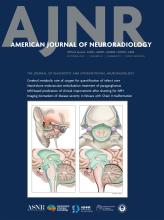This article requires a subscription to view the full text. If you have a subscription you may use the login form below to view the article. Access to this article can also be purchased.
Abstract
BACKGROUND AND PURPOSE: Hemorrhagic transformation remains a potentially devastating complication of acute ischemic stroke. We aimed to evaluate whether the hypoperfusion intensity ratio, a parameter derived from CT perfusion imaging, is associated with the development of hemorrhagic transformation in patients with anterior large-artery occlusion who had undergone thrombectomy.
MATERIALS AND METHODS: We retrospectively reviewed data from patients with consecutive acute ischemic strokes who had achieved successful recanalization (Thrombolysis in Cerebral Infarction score ≥2b) between January 2020 and December 2023. HIR was defined as the ratio of the volume of lesions with a time-to-maximum (Tmax) >6 seconds to those with a Tmax >10 second delay. The primary outcome, based on the European Cooperative Acute Stroke Study, was hemorrhagic transformation, diagnosed by follow-up imaging assessment in 24-hour windows, and radiologically classified as hemorrhagic infarction and parenchymal hematoma. The secondary outcome was a 3-month mRS score of ≥3.
RESULTS: Among 168 patients, 35 of 168 developed hemorrhagic transformation; 14 of 168 developed hemorrhagic infarction, and 21 of 168 developed parenchymal hematoma PH. After adjusting the latent covariates, increased hypoperfusion intensity ratio (per 0.1, adjusted OR [aOR] 1.68, 95% CI 1.26–2.25), ASPECTS (aOR 0.44, 95% CI 0.27–0.72), onset-to-puncture (aOR 1.01, 95% CI 1.00–1.02), and cardioembolism (aOR 5.6, 95% CI 1.59–19.7) were associated with hemorrhagic transformation in multivariable regression. The receiver operating characteristic curve indicated that hypoperfusion intensity ratio can predict hemorrhagic transformation accurately (area under the curve = 0.81; 95% CI, 0.738–0.882; P < .001) and predict parenchymal hematoma (area under the curve = 0.801; 95% CI, 0.727–0.875; P < .001).
CONCLUSIONS: Upon admission, hypoperfusion intensity ratio, an imaging parameter, predicted hemorrhagic transformation after reperfusion therapy in this patient population.
ABBREVIATIONS:
- AIS
- acute ischemic stroke
- aOR
- adjusted odds ratio
- EVT
- endovascular thrombectomy
- HI
- hemorrhagic infarction
- HIR
- hypoperfusion intensity ratio
- HT
- hemorrhagic transformation
- LVO
- large vessel occlusion
- OTP
- onset-to-puncture
- PH
- parenchymal hematoma
- ROC
- receiver operating characteristic
- Tmax
- time-to-maximum
- © 2024 by American Journal of Neuroradiology
ASNR members
Login to the site using your ASNR member credentials












